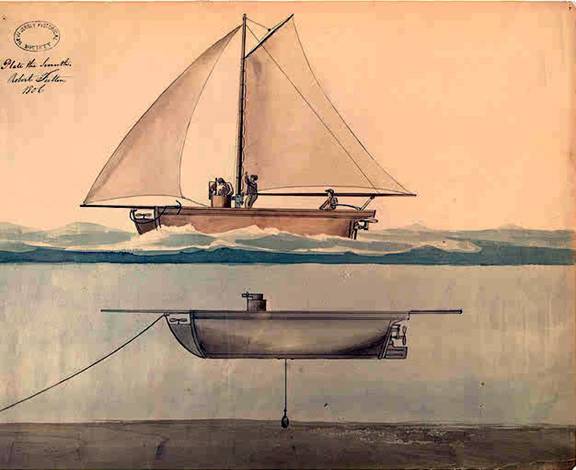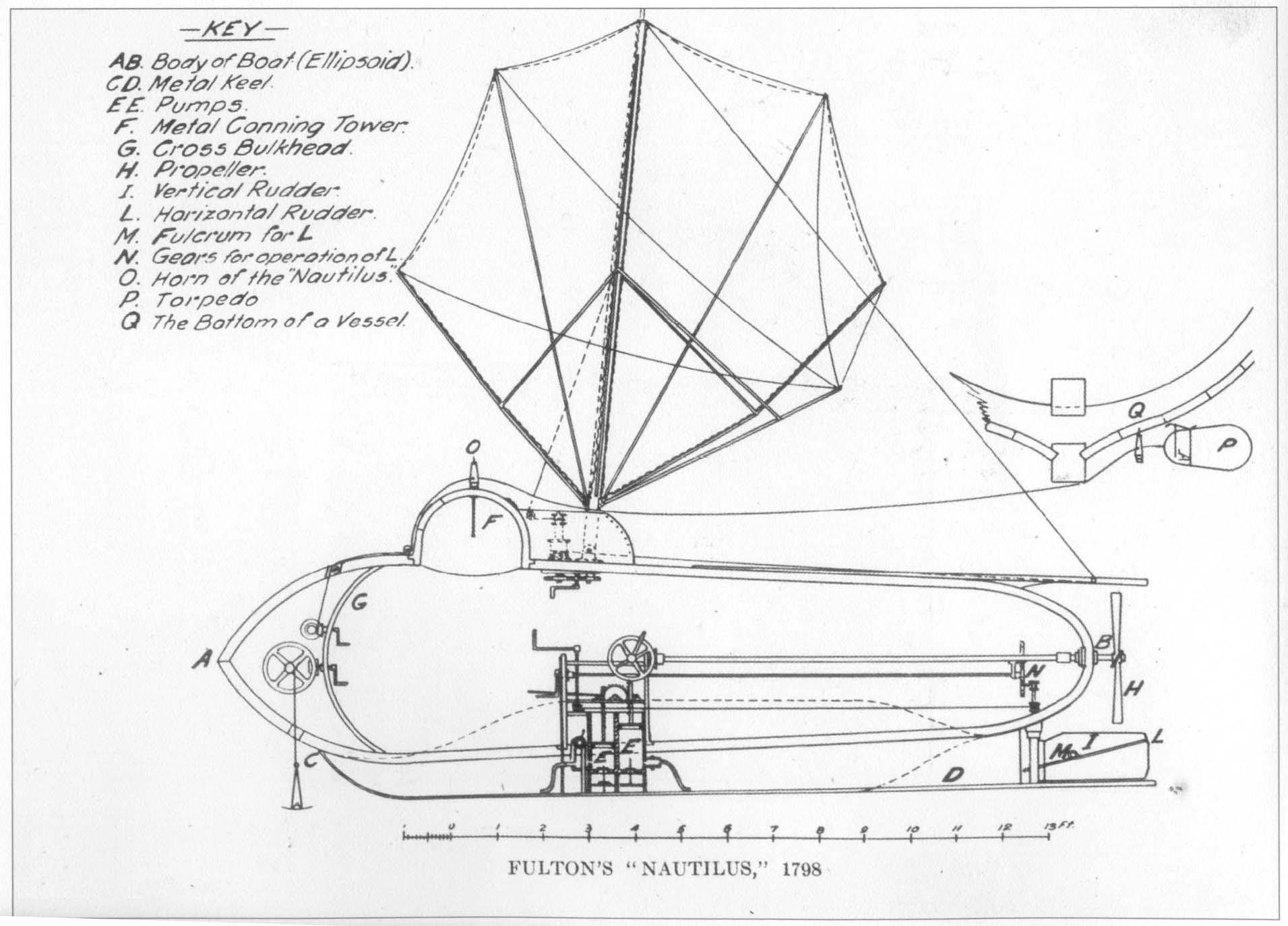le Nautilus de Robert Fulton
For English version, please click on the flag ![]()
Le Nautilus fut le premier sous-marin vraiment opérationnel. Il fut commissionné par le le Premier Consul Napoleaon Bonaparte
et conçu par l'Américain Robert Fulton qui vivait alors en France. Après la défaite navale d'Alexandrie, le gouvernement
Français octroya à Fulton une somme de 10 000 Francs pour construire un prototype.
Le Nautilus fut lancé en 1800. Il était bati de feuilles de cuivres sur une charpente en fer. Long de 6,5 mètres, et large
de 2 mètres, le Nautilus possédait un kiosque pour l'observation.
Des gouvernails étaient utilisés pour controler les mouvements horizontaux et verticaux. Des réservoirs d'air compressé
permettait une submersion de quatre hommes pendant six heures !

Le nautilus était propulsé par une hélice à quatre pales qui était mue à la main par l'équipage. En surface, a mat et une voile était déplié permettant une navigation classique à la voile.
Le Nautilus fut testé en France en 1800- 1801. Après une première plongée dans la Seine à Rouen, les essais se poursuivent au large du Havre en 1800 (an VIII), puis en 1801, au large de Camaret, non loin de Brest. Grâce à ses ballats, le Nautilus pouvait descendre à une profondeur de plus de huit mètres
Ce premier sous-marin coula un shooner en utilisant une mine d'un genre particulier : Un tonneau rempli de poudre que Fulton appela "Torpille" d'après de poisson électrique.
Cette réussite ne réussit pas à convraincre le gouvernement Français à continuer les essais.
Fulton proposa son prototype au Royaume-Uni qui ne fut pas non plus intéressé, malgré que le fait que le Nautilus réussit à couler une barge d'un tonnage de 300 tonnes.

De retour en Amérique en 1810, Robert Fulton poursuivit ses essais avec des fonds alloués par le Congres. Mais il mourut avant d'avoir terminé ses travaux sur une nouvelle version du Nautilus.
Jules Verne se souviendra du Nautilus de Fulton quand soixante-dix ans plus tard quand il écrira Vingt mille lieues sous les mers.
The Nautilus of Robert Fulton
Nautilus was the first practical submarine, commissioned by First Consul Napoleon Bonaparte and designed by the American inventor Robert Fulton, then living in the French First Republic. Launched in 1800, it was made of copper sheets over iron ribs, 6.5 m long with a conning tower for observation. It used rudders for vertical and horizontal control — the origins of the diving planes used on all modern submarines — and tanks of compressed air to give the crew of four a submerged endurance of six hours. Underwater, Nautilus was propelled by a four-blade propeller turned by hand. On the surface a folding mast was erected and the vessel was powered by sail.

Nautilus was tested in France in 1800–1801, when Fulton and three mechanics descended to a depth of 8 m using ballast tanks. Nautilus sank a schooner using a towed gunpowder charge that Fulton called a "torpedo" after the electric ray. However, the French were not impressed and stopped Fulton's funding in 1804.
Fulton took Nautilus to the United Kingdom of Great Britain and Ireland and sank a 300-ton brig in 1805. The Royal Navy, however, was not interested.
Robert Fulton was born in Little Britain in Pennsylvania (now re-named Fulton). He was a successful inventor and lived in England for a while. He approached the French to sponsor building of the "Nautilus" in 1797. Following defeat of Napoleon at Alexandria as a result of British seapower, the French gave Fulton a grant of 10,000 francs to create a submarine. This was a success and was proven in the Seine and in the Rade de Brest in 1801. The craft was 21 feet four inches long and 7 feet in diameter. Propulsion was by a screw, operated by hand.
There was a further successful trial of the submerbible at Falmer in England and William Pitt - Prime minister- was shocked at the effectiveness of the craft. As a result the govenment of the day turned the invention down, rather than endorsing and advertising its potential success as a threat to John Bull's sea power.

In 1810, back in America, Fulton persuaded Congress to vote money to the tune of 5,000 dollars for his next project. This was the "Mute," so called because of its silent steam propulsion. Fulton died before he could develop the craft further.